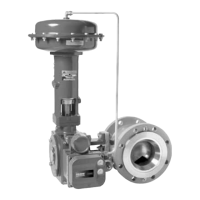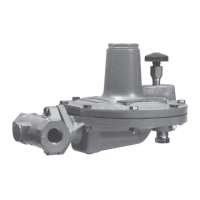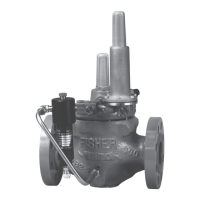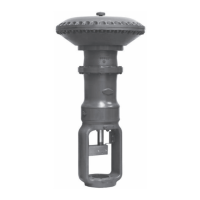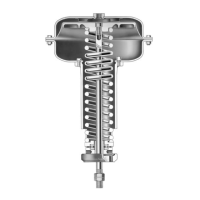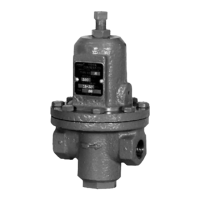Instruction Manual
D101322X012
1051 and 1052 Size 33 Actuators
June 2017
5
CAUTION
To avoid parts damage, do not use an operating pressure that exceeds the Maximum Diaphragm Casing Pressure (table 1)
or produces a torque greater than the Maximum Allowable Valve Shaft Torque (see Catalog 14). Use pressure‐limiting or
pressure‐relieving devices to prevent the diaphragm casing pressure from exceeding its limit.
The actuator, as it comes from the factory, is normally mounted on a valve body. Follow the procedures given in the
valve instruction manual when installing the control valve in the pipeline.
If a positioner is ordered with the actuator, the pressure connection to the actuator is normally made at the factory. If
it is necessary to make this connection, run either 1/4 inch pipe or 3/8 inch tubing (for standard diaphragm case
fittings) between the pressure connection and the instrument. Keep the length of tubing or pipe as short as possible to
avoid transmission lag in the control signal.
When the control valve is completely installed and connected to the controlling instrument, check to make sure that
the action is correct (air‐to‐open or air‐to‐close) and that the controlling instrument is properly configured for the
desired action. For successful operation, the diaphragm rod, lever, and valve shaft must move freely in response to
changes in the loading pressure on the diaphragm.
Actuator Mounting and Changing Actuator Mounting
Use the following steps to mount the actuator or to change actuator mounting style or position.
F and G Mounting Adaptations
Unless otherwise specified, key numbers referenced in the following procedures are shown in figure 9 for the 1051
actuator and in figure 10 for the 1052 actuator.
1. Proceed as appropriate:
If the Actuator is mounted on a valve body and it is necessary to change mounting style or position, the actuator must
first be separated from the valve body. Proceed to the Disassembly portion of the Changing or Replacing Actuator
Lever procedure, observe all warnings, perform steps 1 through 6, and return to step 2 which follows.
If the Actuator is not mounted on a valve body, proceed to the Disassembly portion of the Changing or Replacing
Actuator Lever procedure, perform steps 2 through 5, and return to step 2 which follows.
2. Refer to figure 2 for available mounting styles and positions. When mounting on a Vee‐Ball™ V150, V200 or V300
valve, check the valve manual to determine if it is Series B. The actuator is normally positioned vertically with the
valve in a horizontal pipeline.
3. Determine whether the actuator mounting yoke (key 22) will be mounted on the housing cover assembly (key 33)
side or on the actuator housing boss side of the actuator. If the desired mounting position and style require moving
the mounting yoke and travel indicator (key 35) to opposite sides of the actuator, remove the machine screws (key
38), the travel indicator pointer (key 37), the machine screws, and the travel indicator scale (key 35). Remove the
cap screws (key 23) and the mounting yoke. Install the mounting yoke in the desired position (on the housing cover
assembly or on the actuator housing boss). See table 2 for recommended torque for the mounting cap screws.
Install the travel indicator components on the opposite side of the actuator. See figure 14 for travel indicator
components used with wrench‐operated extensions and manual actuators.
4. Before sliding the valve shaft into the lever, position the valve ball or disc as follows:
For push‐down‐to‐close action, the valve ball or disc should be in the fully open position.
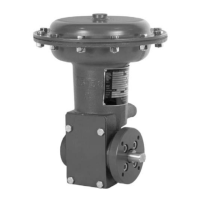
